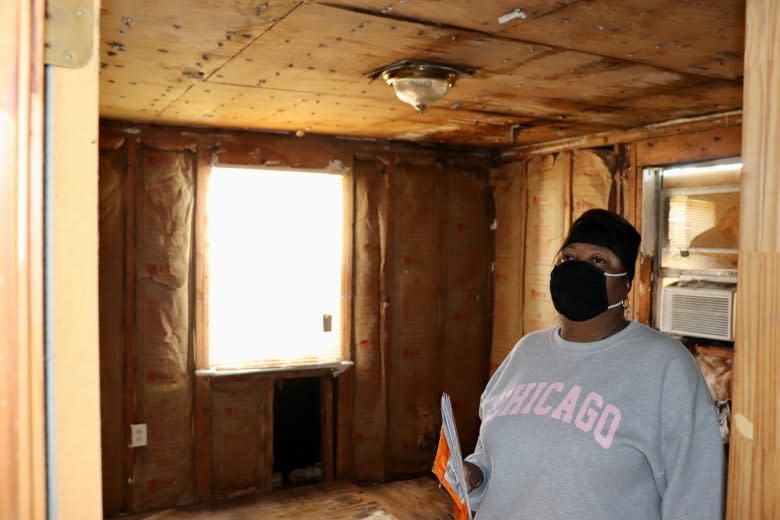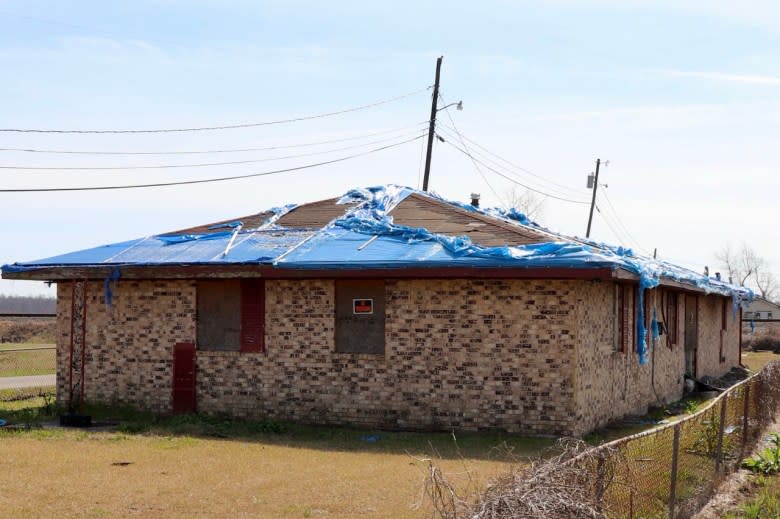Will FEMA’s New Rules Shorten Black Communities’ Road to Recovery?
EDGARD, La. — Flapping in the wind, blue roof tarps still mark Hurricane Ida’s wrath.
It has been 29 months since the second-most damaging storm to hit Louisiana, bringing gaps in the country’s federal aid and recovery process to the forefront.
Beneath the tarps, idle homes sag into the earth as the shadowy bloom of mold has become the only life flowing through them. In Edgard, which is 90% Black, dozens of the town’s roughly 400 homes still sit abandoned.
In recent years, the Federal Emergency Management Agency, the group tasked with disaster recovery, has often been accused of using racist policies that have stunted the recovery process for the state with the second-highest share of Black residents and allowed ghost towns to prop up in the aftermath.
FEMA has taken steps to address these complaints. A few months after the storm, they said they’d begin implementing equity measures, like cataloging victims’ race, and recently partnered with the NAACP on a national plan to “work together to help people before, during, and after disasters.”
But in the most significant move toward equitable recovery, the agency announced broad changes last month that will help disaster victims get financial support quicker with less paper shuffling and fewer rules.
In theory, the changes are most beneficial for communities like Edgard that occupy the front lines of climate change yet lack the everyday resources to prepare and recover from storms.
“For decades, Black communities have been disproportionately impacted by disasters because of the historically racist housing policies and government bureaucracy,” a FEMA spokesperson wrote in a statement to Capital B. “Recognizing this and the realities of historically underserved communities, FEMA and the Biden Harris Administration … have undertaken several initiatives to reduce barriers, so all people, including those from vulnerable and underserved communities, are better able to access our assistance.”

But, in practice, the process may still enforce an unfair “waiting game” that ultimately favors those with the most money in their bank account, said Maria Populis, a Hurricane Ida victim, and other experts, both those who’ve experienced the recovery process firsthand and those who research its effects.
“When you have no money to come out of pocket like me, you know, you would still just have to wait, and even then, it’s probably not enough,” she said.
In the five months after Ida, Louisiana’s unhoused population increased by 130% as small towns statewide mimicked Edgard in large part due to a convoluted federal aid and recovery process, experts say.
There are countless other Louisianans, like Populis, who remain battling through housing insecurity years later. Last March, she told Capital B she feared she’d soon be homeless. In November, her fears were realized when the trailer home provided to her by FEMA was confiscated.
“It was difficult,” Populis said, “wondering and having no idea where I was gonna end up.” The stress is still heavy in her voice. Since the hurricane hit, her health has degraded, intensified by stress and anxiety, which has left her unable to work. She now depends on her family for shelter as her home sits uninhabitable. “Right now, the way things are going, it’s rare to be able to sleep at night.”
“In a press call, FEMA Administrator Deanne Criswell acknowledged the agency could do better, especially as weather disasters become more frequent. “Survivors deserve better,” she said. “Mother Nature is not letting up.”
Fixing the “waiting game”
FEMA’s most substantial change involves allowing disaster-stricken households to automatically qualify for $750 to cover immediate expenses and simplifying the appeal process for households initially denied large sums of aid. It has also removed barriers at the state level and practices that put disaster victims who applied late at a disadvantage, setting the stage for individual victims to potentially receive thousands of dollars more than before.
In a significant win, the agency said its new policies will increase the number of people eligible for aid after every disaster. Still, Populis and disaster recovery experts hope these changes will retroactively be applied to those who’ve been stuck in the process for months and years. In small rural towns, which often feel these disasters the hardest and have the least access to the internet, it is especially important that these changes are communicated to people.
While speeding up the process is much needed, the crisis around recovery is just as much about how expensive it is as it is about how long it takes. Throughout the past year, Capital B has interviewed more than a dozen victims who’ve shown that the overwhelming scale of disasters and the underwhelming federal financial resources have not filled the holes burst open by hurricanes, floods, fires, and tornadoes.
Despite Black Americans, for example, being the most likely to live in flood zones, Black neighborhoods receive an estimated 10% less recovery aid than white ones. It has substantially contributed to the racial wealth gap in the South, studies show.
After being forced north after Hurricane Harvey destroyed thousands of properties in his town, Hilton Kelley remembers waiting for a cot at a shelter in Dallas and noticing only Black and brown faces in line with him.
“Are they better insured? Are they already taken care of? Do they have a special line that they could go to and stand in?” Kelley remembers wondering about the lack of white people needing shelter. It was when he first realized how the recovery aid process has been made easier for white communities.
A 2019 study found that survivors of Hurricane Harvey were less likely to receive FEMA grants if they lived in neighborhoods with more racial minorities compared with neighborhoods with more white residents.
Kelly believes interpersonal biases and racism plays a big role in how homes owned by Black people are valued and how disaster victims are treated. “There are people that still feel the way they feel in all these different agencies and departments,” he said, “And because of that, we will always have those people in high positions and low positions seeking to find a way to shortchange Black communities and those people living in moderate to low-income communities.”
“They’re telling us our communities don’t deserve top dollars”
In addition to removing some of its documentation requirements, FEMA will stop making disaster victims prove that they were spending their aid on rent to remain eligible for continued assistance.
FEMA will now also assist displaced residents who choose to stay with family or friends, like Populis has, instead of making them stay in specified places. This specific change invokes memories of when the agency forced displaced Hurricane Katrina victims to remain in particular trailers, which had high formaldehyde levels, that were later connected to more than 11,000 health complaints.
Read More: Want to Better Prepare Black Communities for Disasters? Erode the Income Gap.
In a win for states like Florida and Louisiana, where insurance companies have left in droves, gone bankrupt, and offered pennies on the dollar in payouts, FEMA will pay up to $42,500 toward damage that victims’ private insurers won’t cover. Previously, insured residents were ineligible for federal assistance if they got any money from their carrier, even if the payouts covered little to nothing.
But with rising housing and labor costs, shelling out thousands of dollars means less and less, especially when Black communities are already undervalued.
“When it comes to FEMA, our property value is not registered as valuable as those in other areas, and with their payouts, they’re telling us our communities don’t deserve top dollars,” Kelley said.

Populis has seen the devaluation firsthand. She initially received $9,000 from FEMA despite estimates to fix her home pushing $40,000. She is currently in the appeal process to receive more support, a process that FEMA has pledged to rework but that she will currently not benefit from.
The rule changes go into effect on March 22, and as it is currently outlined, victims of a disaster declared on or after that date will be the only ones to benefit from these reforms. The changes are expected to cost upwards of $675 million annually, with $160 million covered by the states where the disasters occur.
At the end of the day, Kelley and Populis understand that when a storm rolls through, there is little that most people can do without depending on government support, particularly if they lack the financial resources.
“I do not have a lot of faith in FEMA unless they bring those that they’ve wronged to the table with them,” Kelley said. “But for a lot of people, there isn’t a choice either way.”
Despite it all, Populis still has faith that she’ll be back in the house five generations of her family have called home. Since her neighbor, who was like a father to her, passed away a few months ago, leaving his spouse alone in their home, her sense of urgency to get back in her home has picked up.
“I have to get back to her so I can watch over her,” she said. Her goal is to return before Ida’s three-year mark in August; the days are dwindling.
This story has been updated.
The post Will FEMA’s New Rules Shorten Black Communities’ Road to Recovery? appeared first on Capital B News.

